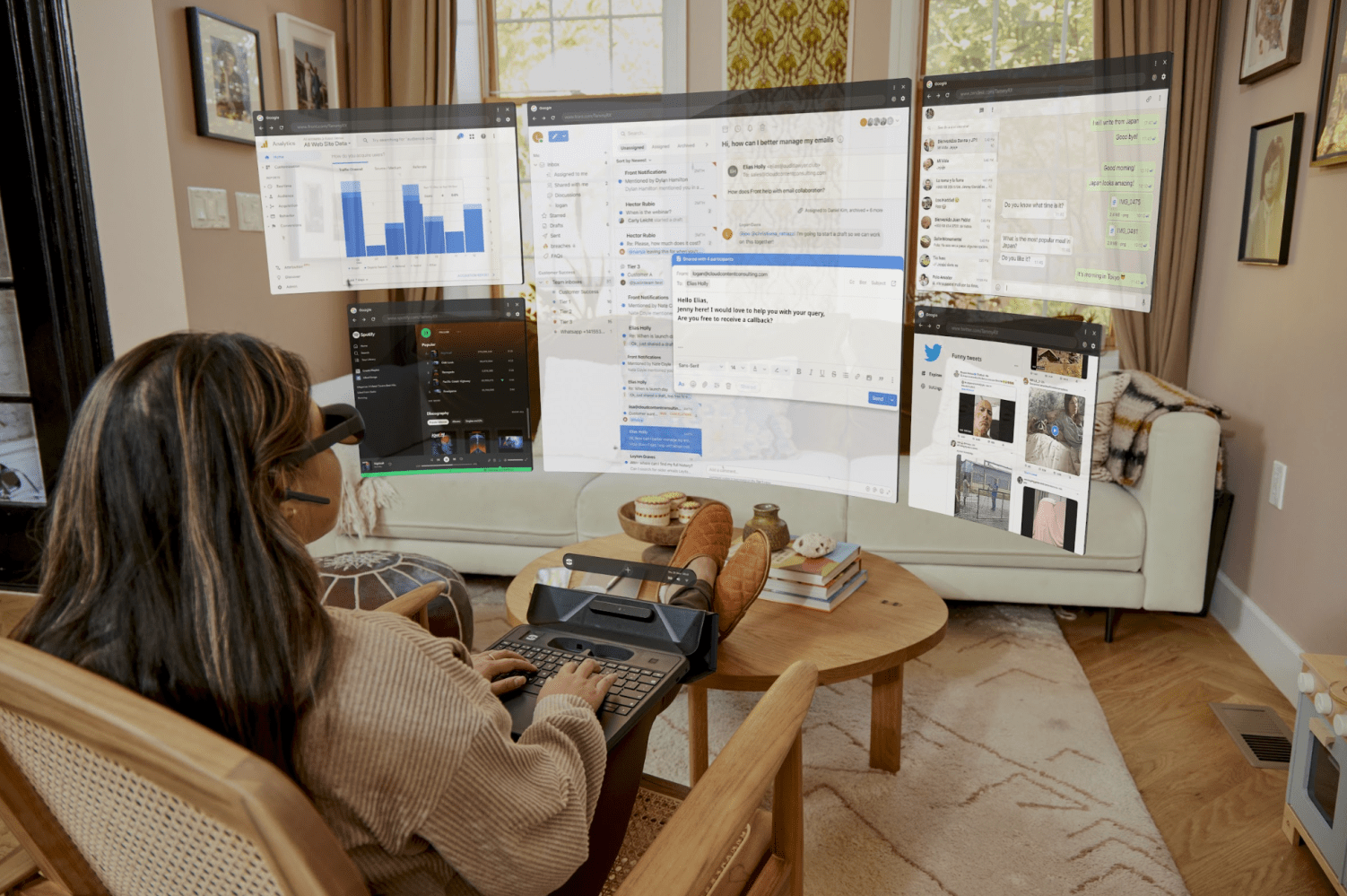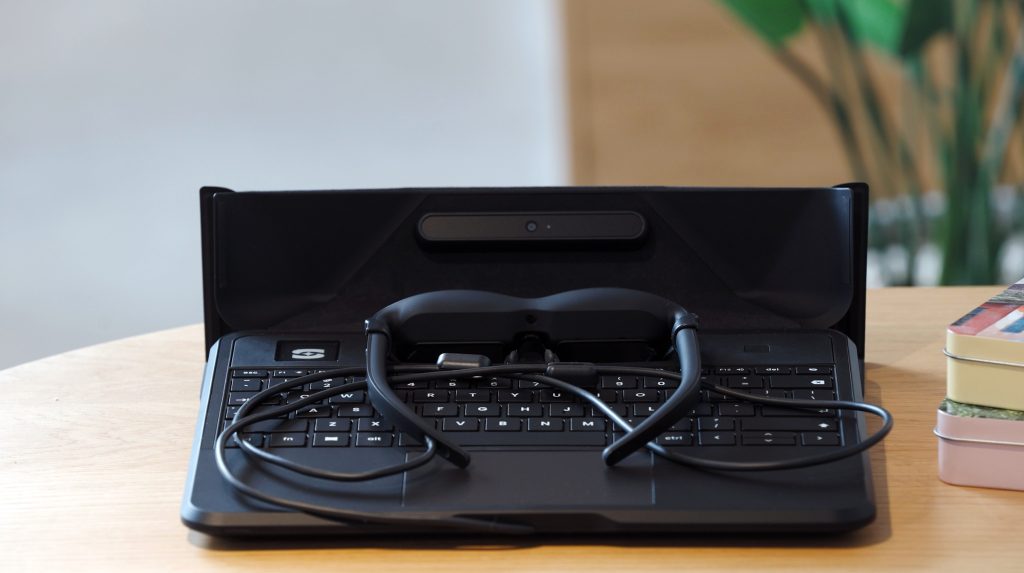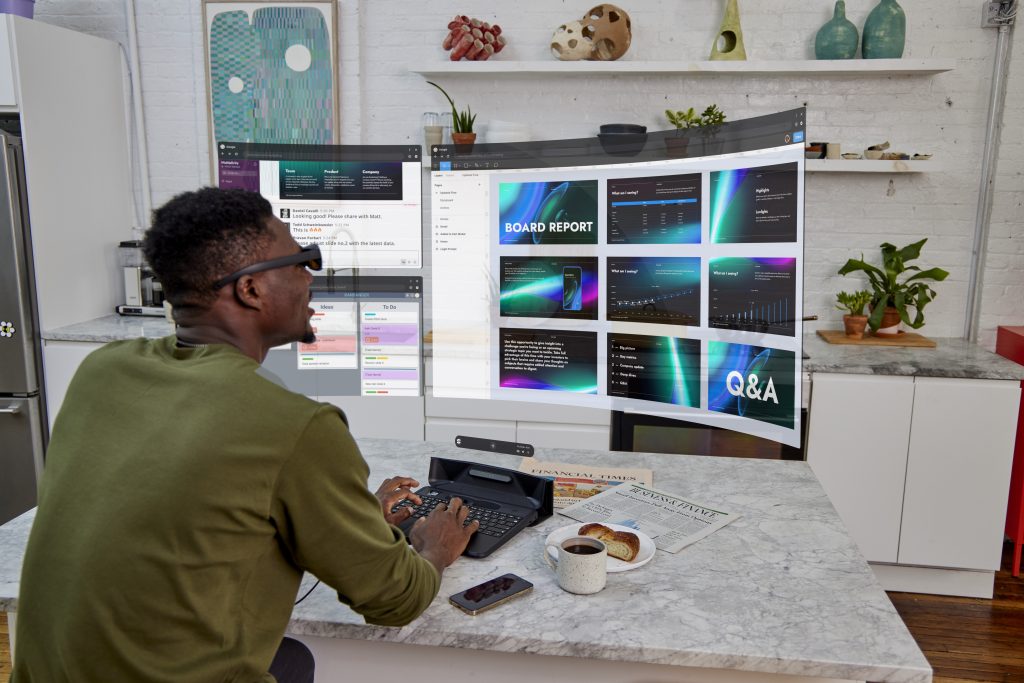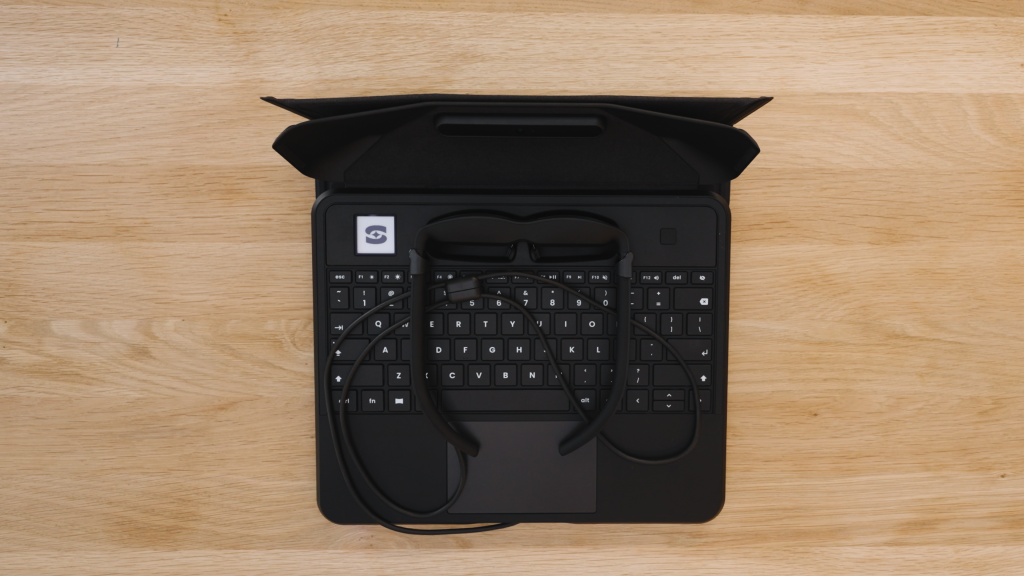
Apple’s AR/VR headset is set to be revealed in less than a month at WWDC, yet we still know very little of how this technology will work and what Apple’s use cases will be. Interestingly, this week I got a look at what I’d consider the first applicable workplace augmented reality tech for the masses from Sightful, a company founded by former developers of Apple’s acquired PrimeSense.
I don’t think the timing was a coincidence.
Spacetop hardware
Spacetop is a little laptop-like apparatus – except instead of a fold-out screen, a set of AR glasses rests on top of the keyboard/touchpad enclosed in a foldable case. The AR glasses are tethered to the “laptop” by a relatively short, pliable cable that carries both power and data from the base. There’s a camera for video conferencing, touchpad, and all the typical ports.
The glasses are augmented reality, not virtual reality, so you can see through their transparent glass and screens even when the power is off. When turned on, there is a set of tiny 1080P displays that give your eyes the illusion of a 2K display. As the user looks around, the screens follow with the software creating a virtual 100-inch display. The glasses also include two small speakers located near but not over the ears similar to Bose Frame glasses.

While obviously thicker than a 13-inch laptop, it is just as light and mostly as portable. It will also offer similar battery life, a touchpad, and USB-charging/ports.
Why not just tether to a MacBook/laptop?
My initial reaction to this product was, yeah, just plug some AR glasses into a Mac or PC via HDMI port, give me an OS I’m already great at, and let me go. It turns out, it isn’t that easy.
Spacetop is based on Open-Sourced Android variant, and the developers say that they’ve been able to really tailor it to the AR experience more than they could with a desktop OS as well as optimizing battery life. It feels a lot like a “Virtual ChromeOS” with great access to Google’s apps. Apple clearly won’t just slap MacOS to your face either, with its RealityOS/xrOS planned.
Okay then why not ‘Minority Report’ UI?
One look at the huge virtual display and my mind wonders to the movie Minority Report. I’m told that a gesture UI could all come in time, and indeed there are cameras in front of the glasses that could decode hand gestures. But according to the founders, the correct way to get these into people’s hands and hearts is to present a use case that people are familiar with – the laptop experience.
Once the Spacetop gets off the ground, gestures could be an easy way to set up virtual windows and move them around. For starters. A speech/audio interface will also be important.
This is where I see Apple shining. The company that taught us to use a mouse and then taught us to swipe will now teach us how to navigate augmented reality using some gestures.
Sightful Spacetop hands-on
Sightful gave us a little hands (+eyes+ears)-on to quickly show how the Spacetop works. The glasses were heavily padded in the nose and around the head so they felt easy to put on, and soft if not slightly heavy. The lenses extend further forward than typical sunglasses but otherwise, excluding the big cable coming out the back, you might be able to fool someone into believing you are wearing normal sunglasses.

That said, it is pretty easy to see what is being done. One of the presenters said he was working with a Spacetop at a coffee shop and a kid asked him if the display was in the glasses. That’s the overriding feeling when using this: It seems obvious once the display is on and it is being used. Why did it take this long to make this product?
I opened a few different-sized browser windows with Google Docs and Gmail and played a Youtube video all simultaneously. There wasn’t any lag and it felt very natural, like I had my two curved 35-inch monitors from home going. The sound coming from the glasses was stereo and decent. What’s nice but also weird is if you get up and move around, your virtual monitor stays in the same place – so you can walk around to the side or back of your virtual monitor and then return to your desk and it is still there. To reset the monitor location in front of you, you hit both /shift/ keys simultaneously.
All the while, you can see outside of the virtual monitors through the transparent glass. That, I’m told, really helps avoid disorientation and dealing with things like motion sickness – which is a huge problem for enclosed virtual reality systems.

Focus was decent but spreading those two tiny 1080P displays didn’t feel “retina.” Small text was readable however, and moving from left to right displays was pretty seamless no matter how quick I moved my head.
Something interesting: I wear reading glasses but didn’t need them for this application because even though the screens were an inch from my eyes, I was focusing out over several feet. Frankly I still don’t quite understand how that part works but it does.
After about 15-20 minutes, I did want to take the headset off however. I’m not sure if it was the 75Hz refresh rate, the weight, or heat but something didn’t feel right. I’m told there is a ramp-up period and a very small amount of people see flickering in the 75Hz displays. I imagine I’d get used to this interface with repeated usage.
If it weren’t for Apple’s AR headset being announced in a matter of weeks, I’d be extremely tempted to throw down $2,000 for one of the 1,000 early builds of the Sightful Spacetop that are going on sale. But at the very least, I need to see what Apple’s going to offer.
Two worlds sit at a crossroads: Laptops are the centerpiece of our daily working lives, but the technology has not evolved with the modern, work from anywhere, privacy matters, “road
Tamir Berliner, CEO and cofounder of Sightful
warrior” mentality. Meanwhile, augmented reality is full of potential and promise, but is yet to find its daily use case. We are at the perfect moment for a significant paradigm shift in a device we all know and love, and Spacetop Early Access is the first step in that journey.




Sightful was founded by ex-Magic Leap executives Tamir Berliner (CEO) and Tomer Kahan (COO), and made up of a rapidly growing team of 60+ employees from places like Primesense, Apple and Microsoft with expertise in product management, UX/UI, core software, cloud, applications, marketing, computer vision, systems, and design. Headquartered in Tel Aviv, Israel with offices in Palo Alto, LA, Taiwan, and Singapore, the company has raised $61M from investors including Corner Ventures and Aleph capital.
Spacetop early access tech specs
Chips:
- Qualcomm Snapdragon 865
- Kryo 585TM 8-core 64-bit CPU, up to 3.1 GHz speed
- AdrenoTM 650 GPU
Battery life: 5+ hours
Memory: 8 GB
Storage: 256 GB
Charging and expansion: 2x US-C sockets, supporting
- PD 3.0 fast charging (up to 65 W)
- Charge from 0% to 85% in less than 2 hours
- SuperSpeed USB up to 10 Gbp/s
- DisplayPort 1.4 (support external Full-HD screen)
Keyboard and touchpad: Full-sized keyboard and clickable touchpad
Wireless: Wi-Fi 6 802.11ax, Bluetooth 5.1 features, 5G NR Sub-6
Top comment by Povie Tam
I'm skeptical. As a quest 2 owner, there is the same functionality. Screens on demand floating right in front of you. I don't like how it feels. partially because the screen door effect is ever present although subtle, it just feels like there is some "there" missing. after 20 minutes I don't want to use it anymore. Maybe apple's version will be different. 4k in each eye will certainly help but the real disruptor will be when ar glasses, actual glasses arrive. When that happens, monitors become pickup trucks.
Video conference camera: 5 MP, Resolution 2560 x 1920
Dimensions: Height: 1.57 inches (4 cm)
Width: 10.47 inches (26.6 cm)
Depth: 9.8 inches (24.9 cm)
Weight: 3.3 lb. (1.5 kg)
Operating system: Spacetop OS
Screen size: 100″ Virtual
9to5Mac’s Take:

So this is the first time I’ve actually seen AR turned into a real product. Sure, I lined up over a decade ago to try Google Glass. I play a bunch of games with my kids on Oculus. I’m always trying out the latest headgear. But I haven’t, until Spacetop, seen a finished product that I want to use. A lot.
Now this could be just one of many features Apple includes in its AR headset, and this company could be toast in a few weeks. But for me anyway, it is showing the next (yet familiar) step for the desktop UI in an augmented reality world.
FTC: We use income earning auto affiliate links. More.




Comments